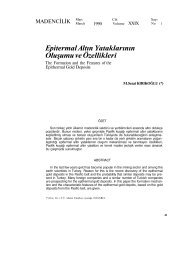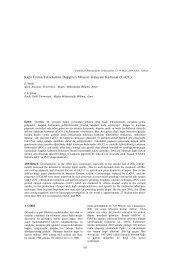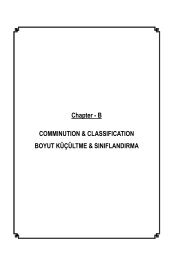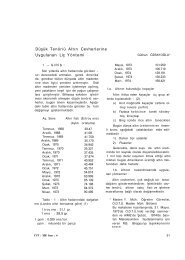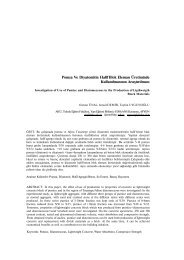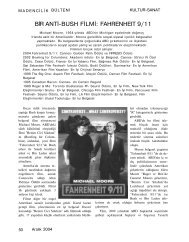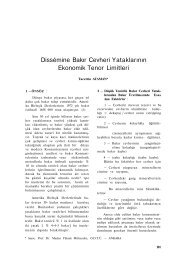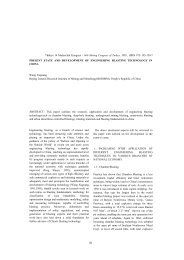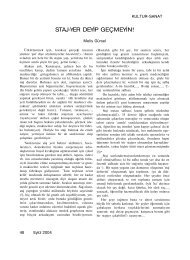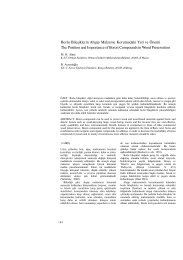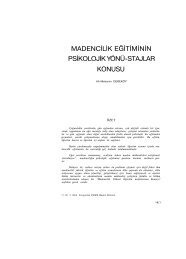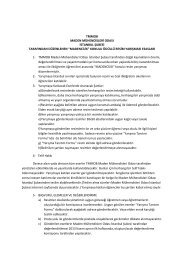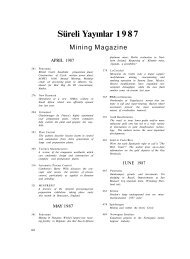A OPEN PIT MINING AÇIK OCAK MADENCİLİĞİ
A OPEN PIT MINING AÇIK OCAK MADENCİLİĞİ
A OPEN PIT MINING AÇIK OCAK MADENCİLİĞİ
Create successful ePaper yourself
Turn your PDF publications into a flip-book with our unique Google optimized e-Paper software.
3.2.3 Separation of alteration zones<br />
associated with gold mineralization<br />
Separation and detection of hydrothermal<br />
alterations is important Privileges of satellite<br />
images. Provided, the effects of them be seen<br />
in the surface of the earth. Hydrothermal<br />
alterations are complex process involving<br />
changes in mineralogy, texture and chemical<br />
reaction that occur from reactions between<br />
the hydrothermal fluids with different origin<br />
(atmospheric or magmatic) and rocks.The<br />
most important minerals formed during<br />
alteration, are iron oxides and clay minerals<br />
with OH that if appears at ground surface,<br />
can be detected by satellite images.<br />
Obviously, introduced area must be<br />
controlled by field operations in order to<br />
confirm the presence or absence of<br />
mineralization.<br />
The purpose of ASTER image processing,<br />
in this part is identified different alteration<br />
zones such as argillic or clay and iron oxide<br />
alterations. For this aim, will be an<br />
unsupervised classification to inform of<br />
spectral classes images (find End member).<br />
It is done in Envi4.2 software with<br />
SMACC algorithm (Sequential maximum<br />
Angle Convex Cone). Likewise determining<br />
end of member, the frequency of each<br />
spectral class in the image is determined.<br />
These classes can be associated with one of<br />
the alteration that these are compared as<br />
visually in image or through the spectral<br />
library. Spectrum associated with alteration<br />
minerals that we are following them is stored<br />
from USGS spectral library separately (Fig<br />
4).<br />
Then, extracted End member from the<br />
image be correlated with mineral spectra in<br />
the library. With identification each<br />
mineral´s absorption and reflection point, can<br />
use different methods in ENVI software for<br />
spectral data analysis.<br />
One of these methods is MATCH<br />
FILTERING. In this way, the reflecting<br />
digital value of each pixel is compared with<br />
reference values of minerals. In other<br />
methods-SAM (Spectral Angle Mapping) -<br />
the nearest spectral angle of the minerals, as<br />
standard, with the nearest spectral angle of<br />
pixels of the image are compared.<br />
Figure 4. Overview of the spectral library in<br />
ENVI software<br />
Finally, the probability distribution of<br />
alteration is obtained. Then with the help of<br />
remote sensing interpretation and geological<br />
maps, are correct and finalized.Extracting<br />
information from satellite images in this<br />
section include: Extraction and detection of<br />
Kaolinitic – Alunite alteration, Illite –<br />
Sericitic alteration, advanced argillic<br />
alteration (with using separation Pyrophillit<br />
mineral), iron oxide, and silica alteration.<br />
Multivariate analysis LS-Fit (Linear Band<br />
Prediction) is another method that was<br />
used.In processing the images in this way,<br />
the bond that have objections with other<br />
types of spectral bands are analyzed.The<br />
results of this method as compared to the<br />
mentioned methods, have a higher accuracy<br />
And the noise is much less.<br />
3.2.1.1 Extraction of iron oxide alterations<br />
The main alterations observed in ASTER<br />
image of studied area is iron oxide<br />
alterations, which with band combination<br />
1,2,3 (ie visible wavelengths) are clearly<br />
separated.As seen in Figure 5, the main<br />
alterations of iron oxide aligned with the NE<br />
– SW tectonic trend .These alterations must<br />
be investigated with field operations until to<br />
be confirmed probable mineralization with<br />
them.<br />
182



